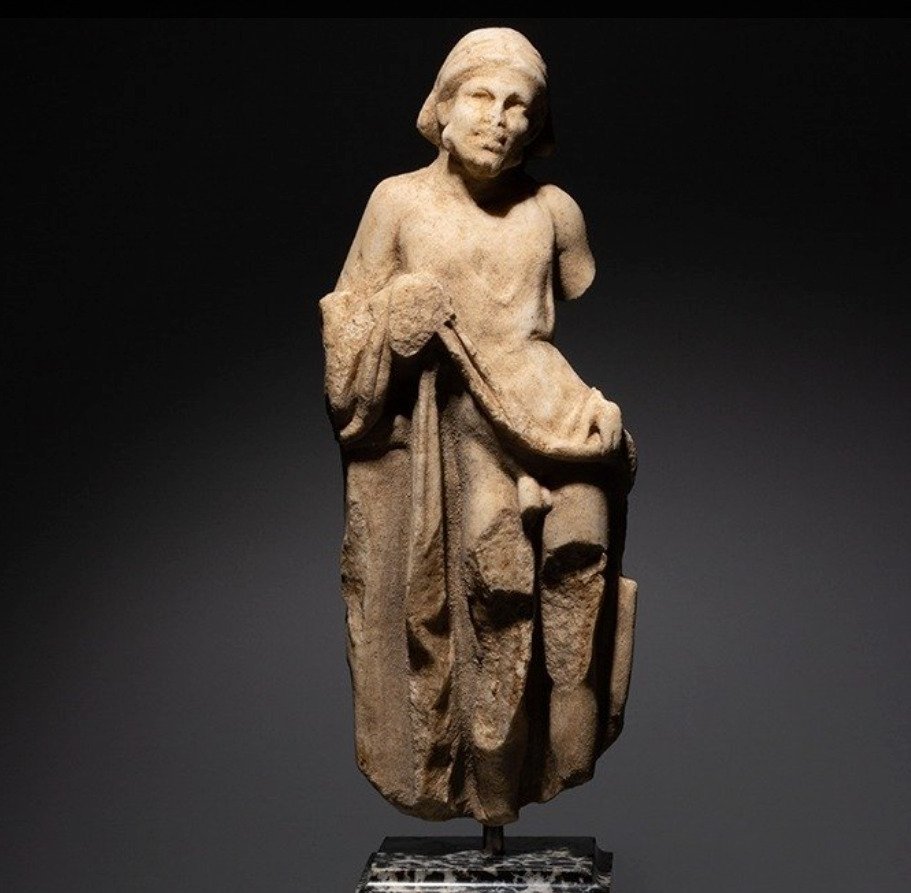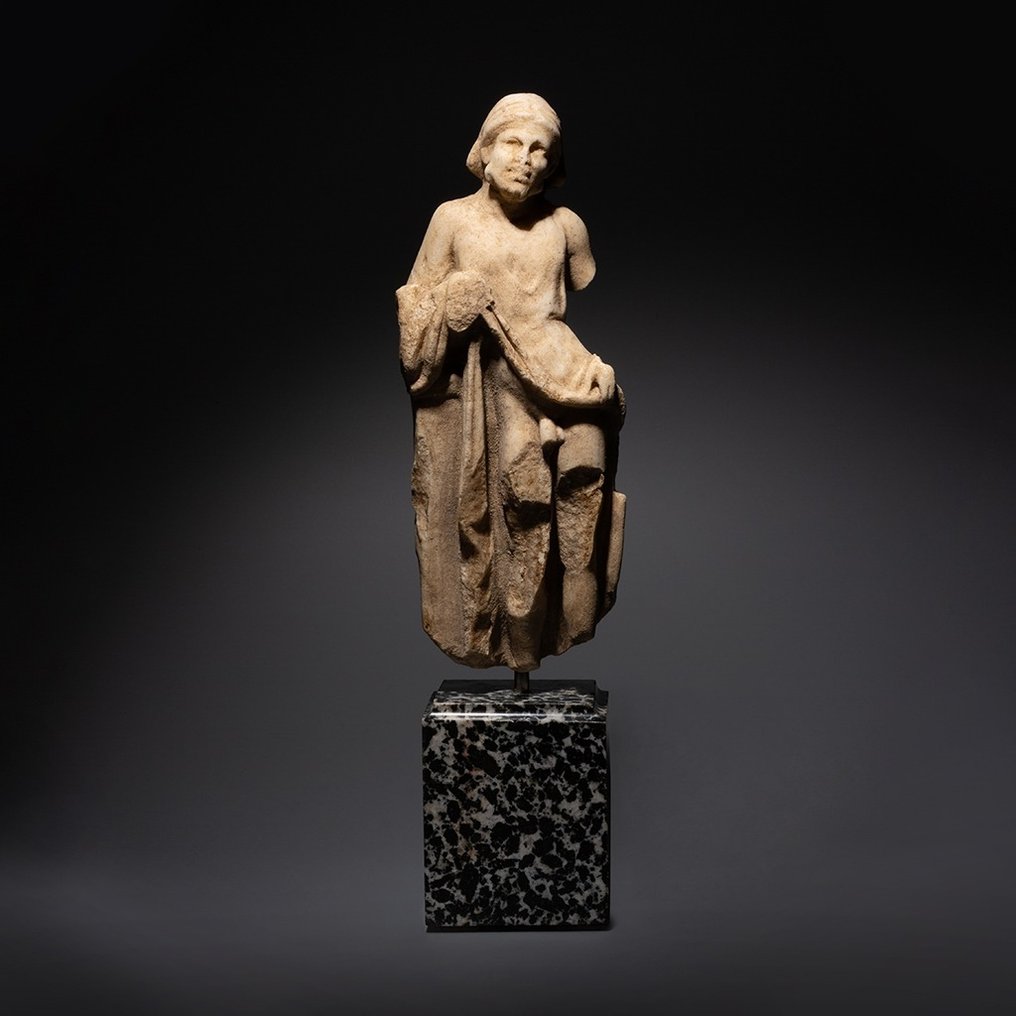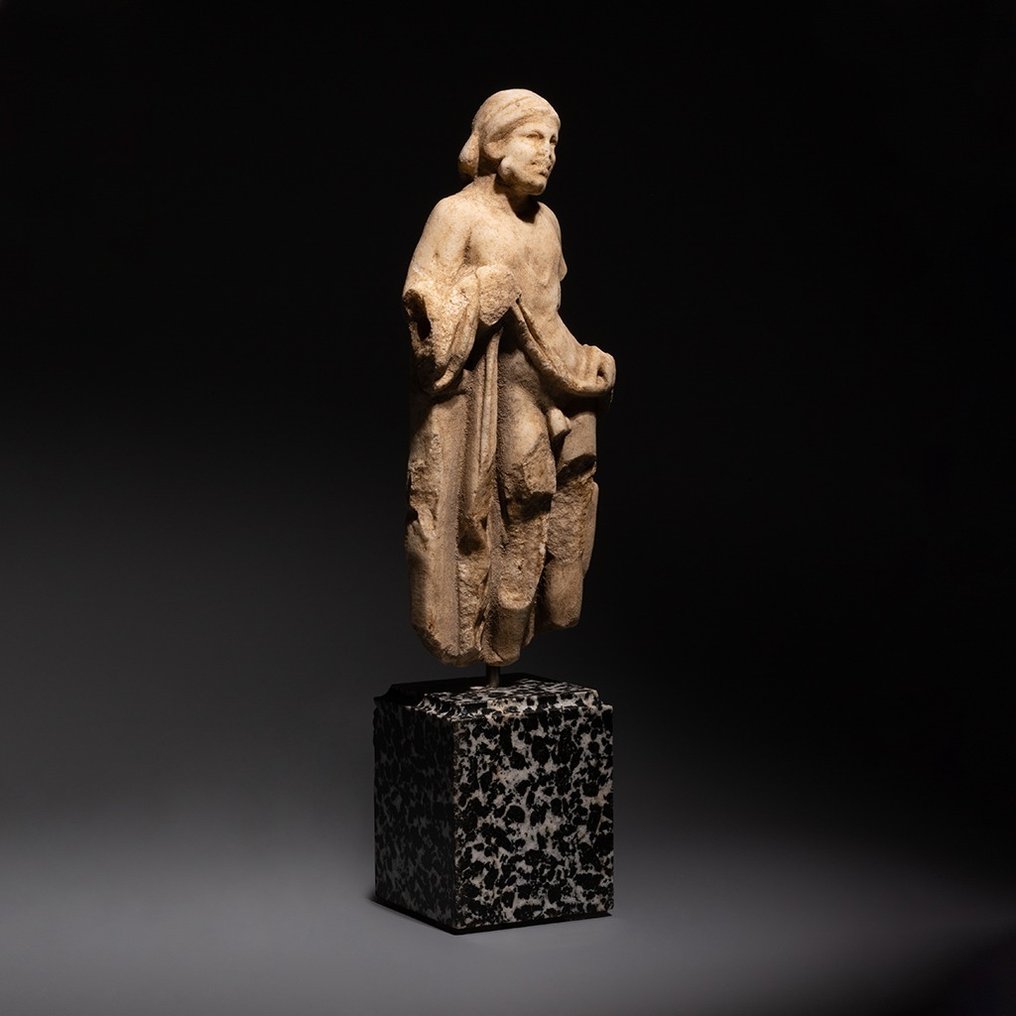Ik heb het goed en snel ontvangen. Het ziet er goed uit. Ben er blij mee.
Fordítás megtekintéseÓgörög Márvány Priapus szobor. Kr.e. 2. - 1. század. 24 cm magas. Spanyol kiviteli engedély
Nr. 89257459



Priapus sculpture.
- Important! -
- Unique! -
Greek Hellenistic, 2nd - 1st century BC
Marble
24 cm Height (without stand)
PROVENANCE: Private collection, London, acquired 1960s - 1980s.
CONDITION: Unrestored, as found. Untouched natural patina.
DESCRIPTION:
Depicted standing, resting on a pillar, in the act of lifting the robe, discovering the genitals; the head is wrapped in a drape and a flap-like extensions beneath the chin representing a cock’s wattle. This rather unique figure of Priapus finds some paralels on groups such as the statue in Berlin which shows the head of the maenad, found before 1872 on the Quirinal near the Piazza Barberini, and a second in the National Museum at Athens where the head of Priapus is preserved. Cf. M. B. Comstock and C. C. Vermeule, Sculpture in Stone, The Greek, Roman and Etruscan collections of the Museum of Fine Arts Boston, Boston, 1976, p. 127, no. 196, for a similar Graeco-Roman group.
We did not found direct paralels for this sculpture since it was never copied in mass scale in roman times, that fact makes this sculpture very unique and unparalllel and a new form of the known corpus of images of Priapus.
Priapus was described in varying sources as the son of Aphrodite by Dionysus; as the son of Dionysus and Chione; as perhaps the father or son of Hermes; or as the son of Zeus or Pan. According to legend, Hera cursed him with inconvenient impotence (he could not sustain an erection when the time came for sexual intercourse), ugliness and foul-mindedness while he was still in Aphrodite's womb, in revenge for the hero Paris having the temerity to judge Aphrodite more beautiful than Hera. The other gods refused to allow him to live on Mount Olympus and threw him down to Earth, leaving him on a hillside. He was eventually found by shepherds and was brought up by them.
Priapus joined Pan and the satyrs as a spirit of fertility and growth, though he was perennially frustrated by his impotence. In a ribald anecdote told by Ovid, he attempted to rape the goddess Hestia but was thwarted by an ass, whose braying caused him to lose his erection at the critical moment and woke Hestia. The episode gave him a lasting hatred of asses and a willingness to see them killed in his honour. The emblem of his lustful nature was his permanent erection and his large penis.
The first extant mention of Priapus is in the eponymous comedy Priapus, written in the 4th century BC by Xenarchus. Originally worshipped by Greek colonists in Lampsacus in Asia Minor, the cult of Priapus spread to mainland Greece and eventually to Italy during the 3rd century BC. Lucian (De saltatione) tells that in Bithynia Priapus was accounted as a warlike god, a rustic tutor to the infant Ares, "who taught him dancing first and war only afterwards," Karl Kerenyi observed. Arnobius is aware of the importance accorded Priapus in this region near the Hellespont. Also, Pausanias notes:
This god is worshipped where goats and sheep pasture or there are swarms of bees; but by the people of Lampsacus he is more revered than any other god, being called by them a son of Dionysus and Aphrodite.
In later antiquity, his worship meant little more than a cult of sophisticated pornography.
Outside his "home" region in Asia Minor, Priapus was regarded as something of a joke by urban dwellers. However, he played a more important role in the countryside, where he was seen as a guardian deity. He was regarded as the patron god of sailors and fishermen and others in need of luck, and his presence was believed to avert the evil eye.
Priapus does not appear to have had an organized cult and was mostly worshiped in gardens or homes, though there are attestations of temples dedicated to the god. His sacrificial animal was the ass, but agricultural offerings (such as fruit, flowers, vegetables and fish) were also very common.
Notes:
The Seller can prove that the lot was obtained legally , provenance statement seen by Catawiki.
Important information. The seller guarantees that he is entitled to ship this lot.
The piece includes authenticity certificate.
The piece includes Spanish Export License (Passport for European Union) - If the piece is destined outside the European Union a substitution of the export permit should be requested.
#MasterpiecesW39
Az eladó története
Priapus sculpture.
- Important! -
- Unique! -
Greek Hellenistic, 2nd - 1st century BC
Marble
24 cm Height (without stand)
PROVENANCE: Private collection, London, acquired 1960s - 1980s.
CONDITION: Unrestored, as found. Untouched natural patina.
DESCRIPTION:
Depicted standing, resting on a pillar, in the act of lifting the robe, discovering the genitals; the head is wrapped in a drape and a flap-like extensions beneath the chin representing a cock’s wattle. This rather unique figure of Priapus finds some paralels on groups such as the statue in Berlin which shows the head of the maenad, found before 1872 on the Quirinal near the Piazza Barberini, and a second in the National Museum at Athens where the head of Priapus is preserved. Cf. M. B. Comstock and C. C. Vermeule, Sculpture in Stone, The Greek, Roman and Etruscan collections of the Museum of Fine Arts Boston, Boston, 1976, p. 127, no. 196, for a similar Graeco-Roman group.
We did not found direct paralels for this sculpture since it was never copied in mass scale in roman times, that fact makes this sculpture very unique and unparalllel and a new form of the known corpus of images of Priapus.
Priapus was described in varying sources as the son of Aphrodite by Dionysus; as the son of Dionysus and Chione; as perhaps the father or son of Hermes; or as the son of Zeus or Pan. According to legend, Hera cursed him with inconvenient impotence (he could not sustain an erection when the time came for sexual intercourse), ugliness and foul-mindedness while he was still in Aphrodite's womb, in revenge for the hero Paris having the temerity to judge Aphrodite more beautiful than Hera. The other gods refused to allow him to live on Mount Olympus and threw him down to Earth, leaving him on a hillside. He was eventually found by shepherds and was brought up by them.
Priapus joined Pan and the satyrs as a spirit of fertility and growth, though he was perennially frustrated by his impotence. In a ribald anecdote told by Ovid, he attempted to rape the goddess Hestia but was thwarted by an ass, whose braying caused him to lose his erection at the critical moment and woke Hestia. The episode gave him a lasting hatred of asses and a willingness to see them killed in his honour. The emblem of his lustful nature was his permanent erection and his large penis.
The first extant mention of Priapus is in the eponymous comedy Priapus, written in the 4th century BC by Xenarchus. Originally worshipped by Greek colonists in Lampsacus in Asia Minor, the cult of Priapus spread to mainland Greece and eventually to Italy during the 3rd century BC. Lucian (De saltatione) tells that in Bithynia Priapus was accounted as a warlike god, a rustic tutor to the infant Ares, "who taught him dancing first and war only afterwards," Karl Kerenyi observed. Arnobius is aware of the importance accorded Priapus in this region near the Hellespont. Also, Pausanias notes:
This god is worshipped where goats and sheep pasture or there are swarms of bees; but by the people of Lampsacus he is more revered than any other god, being called by them a son of Dionysus and Aphrodite.
In later antiquity, his worship meant little more than a cult of sophisticated pornography.
Outside his "home" region in Asia Minor, Priapus was regarded as something of a joke by urban dwellers. However, he played a more important role in the countryside, where he was seen as a guardian deity. He was regarded as the patron god of sailors and fishermen and others in need of luck, and his presence was believed to avert the evil eye.
Priapus does not appear to have had an organized cult and was mostly worshiped in gardens or homes, though there are attestations of temples dedicated to the god. His sacrificial animal was the ass, but agricultural offerings (such as fruit, flowers, vegetables and fish) were also very common.
Notes:
The Seller can prove that the lot was obtained legally , provenance statement seen by Catawiki.
Important information. The seller guarantees that he is entitled to ship this lot.
The piece includes authenticity certificate.
The piece includes Spanish Export License (Passport for European Union) - If the piece is destined outside the European Union a substitution of the export permit should be requested.
#MasterpiecesW39
Az eladó története
- 823
- 9
- 1
Great seller!!
Fordítás megtekintéseBagot siempre rápido y fiable, muchas gracias
Fordítás megtekintésegreat scarab! very fast shipping! thank you very much!
Fordítás megtekintéseTodo bien. Vendedor recomendado.
Fordítás megtekintéseAbsolut vertrauenswürdiger Händler ! Und: ein ganz zauberhaftes Stück !
Fordítás megtekintéseOttimo imballo particolare come da foto
Fordítás megtekintéseTodo bien. Persona muy amable y atenta. Recomendado.
Fordítás megtekintéseTodo bien. Vendedor muy amable y atento. Recomendado.
Fordítás megtekintéseTodo bien. Persona muy amable y atenta. Vendedor recomendado.
Fordítás megtekintéseTodo bien. Envío muy cuidado, de auténtico profesional. Persona, además, muy amable y atenta. Vendedor recomendado.
Fordítás megtekintésea recommander envoi tres rapide est sécurisé embalage tres bien fait vraiment rien a dire plus que parfait
Fordítás megtekintéseBeautiful objects! Extremely fast shipment! I can fully recommend this seller.
Fordítás megtekintésewonderful apis!very fast shipping!thanks a lot
Fordítás megtekintésepezzo bellissimo, e spedito a tempo record, venditore veloce onesto e preciso, consigliatissimo. Grazie
Fordítás megtekintéseAlways a great pleasure !
Fordítás megtekintéseEnvíos siempre con cuidado
Fordítás megtekintéseBuen vendedor
Fordítás megtekintéseObjekte wie abgebildet, das Gefäss sogar noch schöner / unkomplizierter Versand und sehr gut verpackt. Perfekte Transaktion!!
Fordítás megtekintésesuperb, as usual
Fordítás megtekintéseGreat object, fast delivery
Fordítás megtekintéseProfessional seller. Object received s described. Fair price
Fordítás megtekintéseTodo ok
Fordítás megtekintéseWell packed, fast delivery. Arrived safely, in good condition. Thank you!
Fordítás megtekintéseDanke!
Fordítás megtekintése- 823
- 9
- 1
Ik heb het goed en snel ontvangen. Het ziet er goed uit. Ben er blij mee.
Fordítás megtekintéseLemondás
Az eladó garantálja, hogy a tárgy a jogszabályoknak megfelelően került hozzá, és ezt bizonyítani is tudja. Az eladó kapott információt a Catawikitől arról, hogy a tárgyhoz mellékelnie kell a tartózkodási helyének megfelelő jogszabályok alapján szükséges dokumentációt. Az eladó garantálja a tárgy eladását/exportját és jogában áll mindez. Az eladó minden a tárggyal kapcsolatban szükséges információt továbbít a vevőnek. Az eladó biztosítja, hogy minden szükséges engedély el lett/lesz intézve. Az eladó azonnal tájékoztatja a vevőt, amennyiben az engedélyek beszerzése késik.
Az eladó garantálja, hogy a tárgy a jogszabályoknak megfelelően került hozzá, és ezt bizonyítani is tudja. Az eladó kapott információt a Catawikitől arról, hogy a tárgyhoz mellékelnie kell a tartózkodási helyének megfelelő jogszabályok alapján szükséges dokumentációt. Az eladó garantálja a tárgy eladását/exportját és jogában áll mindez. Az eladó minden a tárggyal kapcsolatban szükséges információt továbbít a vevőnek. Az eladó biztosítja, hogy minden szükséges engedély el lett/lesz intézve. Az eladó azonnal tájékoztatja a vevőt, amennyiben az engedélyek beszerzése késik.









